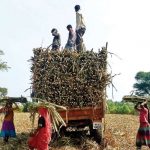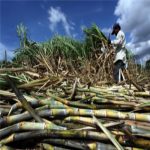New Delhi: In their latest outlook for the global sugar market from 2025 to 2034, the OECD and FAO have projected a slight decline in sugar prices. The two agencies noted that this outlook depends on several factors, including unpredictable weather, Brazil’s continued dominance in sugar exports, and how profitable sugar remains compared to ethanol.
The report highlighted that India’s ethanol production from sugarcane will continue to grow, supported by government policies aimed at diversifying the sugar sector. According to the forecast, India is expected to maintain its position as the third-largest sugar exporter after Brazil and Thailand, contributing about 8% to global exports.
Sugarcane juice and molasses are also used to produce ethanol through a fermentation process. The various sugarcane products and byproducts can be collectively termed as the “Sugarcane Complex” (SCC) and play an important role in the bioenergy sector.
The SCC is closely linked to the energy sector in major sugarcane producing countries like Brazil, India, and Thailand. Brazil’s energy sector has relied on the SCC to produce energy and over the last decade 50% of sugarcane has been used directly in ethanol production. This share is expected to remain stable over the next decade. In Thailand the direct use of sugar cane in biofuels is very limited (below 3%) and is not expected to change
Currently, around 9% of India’s sugar is used to make ethanol. This share is projected to rise to 22% by 2034, the report said.
The rising production of ethanol can be attributed largely to policies supporting the use of domestically produced ethanol, which couple biofuel consumption and fossil fuel consumption, aiming at decarbonizing the transport sector. Additionally, governments have
provided various types of support to promote domestic ethanol production, such as tax credits and support prices for feedstocks.
India’s sugar sector has seen ups and downs over the past two years. Predictions of record-high production were followed by concerns of a shortfall, leading to restrictions on sugar exports and the introduction of a permit system. A forecast of a good harvest early in the current crushing season contributed to falling global sugar prices, but later concerns about declining output caused a sharp rise in prices in February 2025.
The report noted that while India remains the second-largest sugar producer in the world, the pace of growth in its sugar production will slow slightly over the next decade. This is mainly due to slower growth in sugarcane farming and more cane being used for ethanol. However, India is still expected to record the highest increase in sugar production in Asia—8.7 million tonnes by 2034. Asia as a whole is projected to account for 42% of global sugar output by then, with Thailand adding 3.6 million tonnes and China 2 million tonnes.
India will also lead sugar consumption growth in Asia, followed by Indonesia, Pakistan, and China. In these countries—except China—rising incomes and growing populations are expected to drive demand for packaged foods and beverages.
At the same time, the Indian government has launched a campaign to cut down sugar and edible oil intake to help address rising obesity levels.
Globally, demand for sugar is expected to increase in lower- and middle-income countries, particularly in Asia and Africa, where population and income growth will continue. Per-person sugar consumption in poorer countries will likely grow faster, though it will remain below the global average. In contrast, in wealthier nations, sugar intake is expected to stay the same due to slow population growth and a shift toward healthier eating habits. Countries like China and Japan, where people already consume less sugar on average, are expected to maintain low-sugar preferences.
On the production front, sugar output is likely to expand, with sugarcane accounting for over 85% of global supply. Brazil is expected to strengthen its lead in production through expansion and replanting of its sugarcane fields. India and Thailand are also likely to boost output through improved crop varieties and better processing methods. The European Union will continue to be the leading producer of sugar made from sugar beet.
However, global sugar production could face obstacles, the report warned, including competition for land from other crops and limited access to plant-protection products, which could make crops more vulnerable to disease.
Click here to read OECD-FAO Agricultural Outlook 2025-2034 report

















